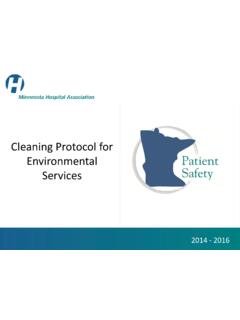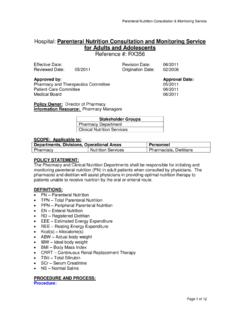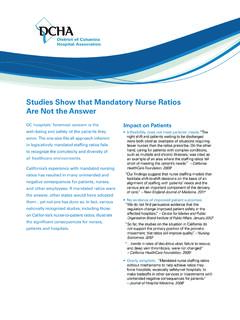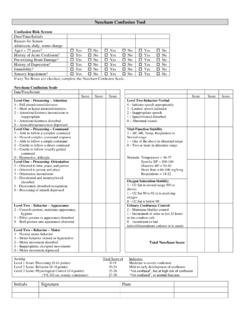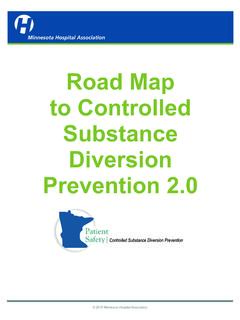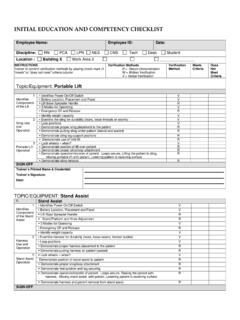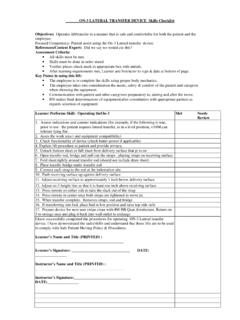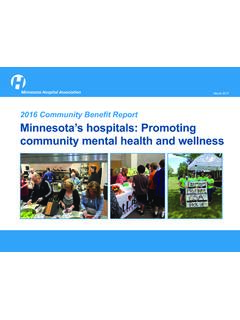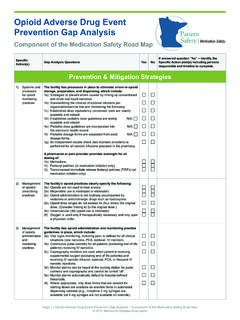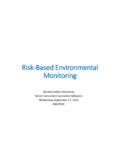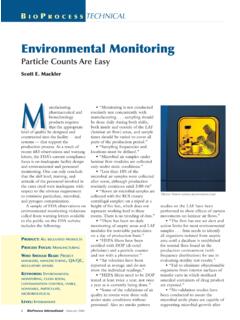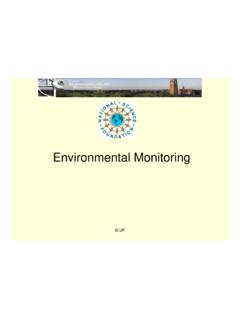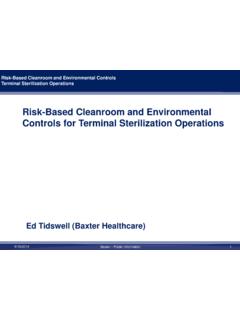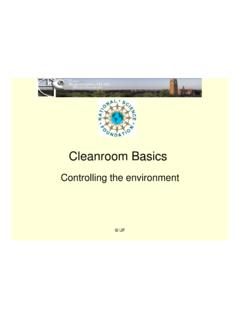Transcription of Environmental Services Cleaning Guidebook - MHA
1 1 Environmental Services Cleaning Guidebook Adapted from Allina Hospitals and Clinics Environmental Services Cleaning Guidebook by the Minnesota Hospital Association (MHA), Minnesota Department of Health (MDH) and Stratis Health, with representatives from: CentraCare Health Melrose, Grand Itasca Clinic and Hospital, Minnesota Valley Health Center, Park Nicollet Methodist Hospital, United Hospital, University of Minnesota Medical Center, and Windom Area Hospital, as a part of the Controlling CDI difficile infection (CDI) is becoming more prevalent as a health care-associated infection, causing diarrhea that can lead to colitis, colon perforation, sepsis, and, according to the Centers for Disease Control and Prevention (CDC), is fatal in approximately 14,000 Americans annually. CDC guidelines have been in place nationally for at least five years, targeting antimicrobial stewardship, early identification and treatment, and the prevention of health care facility transmission.
2 A recent study by Sitzlar, et al. (2013) suggested that effective Cleaning coupled with staff supervision is a powerful method in decreasing the potential for CDI transmission in hospitals. The Minnesota Hospital Association (MHA), in conjunction with Stratis Health and the Minnesota Department of Health (MDH), has been working with seven Minnesota hospitals: CentraCare Health Melrose, Grand Itasca Clinic and Hospital, Minnesota Valley Health Center, Park Nicollet Methodist Hospital, United Hospital - a part of Allina Health, University of Minnesota Medical Center, and Windom Area Hospital, to adapt the Allina Health System Environmental Cleaning training and supervision model for statewide dissemination. The accompanying Environmental Services Cleaning Guidebook and training presentation apply to general infection and control principles, with CDI specific recommendations included, such as bleach or other sporicidal disinfectants.
3 Additional resources provided by our partner hospitals are included in the package and are intended to serve as examples of best practices that hospitals can adopt if found helpful. 4 Table of contentsI) Basic Cleaning concepts ..1 2) High touch areas ..3 High touch area definition ..3 Patient room ..3 Patient Restroom ..43) room zone ..5 Hot zone ..5 room Cleaning path ..64) room Cleaning short forms ..7 Occupied room Cleaning short form ..7 Terminal room Cleaning short form ..85) room Cleaning detailed forms ..10 Detailed occupied room Cleaning form ..10 Detailed terminal room Cleaning form ..126) Isolation Cleaning procedures ..15 Airborne precautions ..15 Contact precautions ..15 Droplet precautions ..15 Enteric precautions ..16 Strict contact precautions ..16 Neutropenic precautions ..167) Equipment specific Cleaning instructions ..178) Personal protective equipment (PPE).
4 26 Protection ..26 Gloves ..26 Isolation gown ..26 Mask ..26 N95 respirator ..27 PAPR ..279) AIDET ..28 Basic AIDET concept ..28 Core customer service values ..29 Examples ..29 Additional notes ..29 10) EVS equipment ..30 Cleaning Cart equipment ..30 Cart supplies ..30 Documentation ..3011) Quality control guidelines ..31 UV testing ..31 Direct observation ..31 Quality standards ..3112) Training requirements ..31 Initial assessments of competency ..31 Yearly training and recertification ..31 Retraining ..31 Attachments ..32 Donning PPE guide ..32 Doffing PPE guide ..33 High touch surface card ..34 High touch surface monitoring tool ..35 Airborne precaution sign ..36 Contact precaution sign ..37 Droplet precaution sign ..38 Enteric precaution sign ..39 Strict contact precaution sign ..40 Neutropenic precautions sign (protective isolation) ..41 AIDET is a registered trademark of Studer Group11) Basic Cleaning conceptsGeneral sanitizingTo make a surface or area clean by removing dirt, germs or unwanted Cleaning includes the Cleaning of toilets, fixtures and commodes.
5 Bathrooms should be cleaned last, after completing the room . Shower walls should be thoroughly scrubbed at least weekly. Shower curtains should be changed at least yearly and as physical removal of dust, soil, blood and body fluids. Cleaning physically removes germs. It is accomplished with water, detergents and mechanical action. The key to Cleaning is the use of friction to remove germs and presence of germs on hands or on a surface such as clothes, gowns, gloves, bedding, toys, surgical instruments, patient care equipment, dressings or other inanimate is the transfer of harmful germs from one person, object or place to product that is used on surfaces or medical equipment/devices which results in disinfection of the equipment/device. Some products combine a cleaner with a killing of germs. Surfaces and equipment must be cleaned first before applying disinfectant in order to kill moppingThe process of removing dirt and debris from floors using only mop head without water or dustingHigh dusting includes all horizontal surfaces and fixtures above shoulder height, including vents.
6 Ideally, the patient/resident should be out of the room during high dusting to reduce the risk of inhaling dust particles. 2 Hospital cleanHospital clean is a measure of cleanliness routinely maintained in care areas of the health care setting. Cleaning practices are periodically monitored and audited with feedback and education. Floors and baseboards are free of stains, visible dust, spills and streaks. Walls, ceilings and doors are free of visible dust, gross soil, streaks, spider webs and handprints. All horizontal surfaces are free of visible dust or streaks (includes furniture, window ledges, overhead lights, phones, picture frames, carpets, etc.) Bathroom fixtures including toilets, sinks, tubs and showers are free of streaks, soil, stains and soap scum. Mirrors and windows are free of dust and streaks. Dispensers are free of dust, soiling and residue and replaced/replenished when empty.
7 Appliances are free of dust, soiling and stains. Waste is disposed of appropriately. Items that are broken, torn, cracked or malfunctioning are replaced. High touch surfaces in client/patient/resident care areas are cleaned and disinfected with a hospital-grade disinfectant. Non-critical medical equipment is cleaned and disinfected between clients/ precautionsInfection control interventions used to reduce the risk of transmission of germs to patients and hospital staff. Includes: contact, enteric, droplet, airborne, strict cleaningThe thorough Cleaning of a patient room following discharge in order to remove germs that might be transferred to the next patient in the moppingFinal floor Cleaning step using water and detergent or from clean areas to dirty areas: Fill plastic basin with Cleaning solution. Place microfiber pad(s) to soak in basin. Take a clean pad from the basin and attach to mop head using Velcro strips.
8 Remove pad when soiled and set aside for laundering. Send soiled microfiber pads for laundering at the end of the Isolation precaution rooms: Take a clean pad from the basin and attach to mop head using Velcro strips. Take a clean microfiber pad from the cart and place in bucket containing disinfectant. Ensure that pad becomes saturated with disinfectant. Wring excess liquid from the pad before attaching to mop. Mop as usual working from clean areas to dirty ) High touch areas High touch areasHigh touch surfaces are those that have frequent contact with hands. High touch surfaces in care areas require more frequent Cleaning and disinfection than minimal contact surfaces. Cleaning and disinfection is usually done at least daily and more frequently if the risk of Environmental contamination is higher ( , intensive care units). Patient room high touch areas Bed hand railsNurse call boxTelephoneBedside tableTelephoneRoom door handles - interior and exteriorLight switchesComputer keyboardsIn- room sinksPatient chair4 Patient restroom high touch areas Toilet handleRestroom light switchRestroom door handle - interior and exteriorToilet seatToilet handle railsBathroom sink53) room zoningHotzoneThe equipment and areas closest to the patient are the most contaminated and considered the hot zone.
9 As you move further from the patient, surfaces are less contaminated. Starting with the bed will allow adequate contact time with the disinfectant. Once the hot zone has been cleaned and disinfected, take a fresh Cleaning rag and work clockwise from cleaner to dirtier (green to yellow ring on the diagram).6 room Cleaning path example1. Disinfect bed using a minimum of one BLUE Starting back at the door use a fresh BLUE rag, begin disinfecting the rest of patient room following a clockwise path. Change rags as needed to assure proper saturation and avoid cross contamination (approximately 3-4 rags).3. Using 2-3 bathroom rags disinfect the restroom and always finish with the : Each hospital is to set standards regarding cloth colors, product selection and number of cloths used per consistent room Cleaning path must be ) room cleaningOccupied room cleaningNote: Each hospital is to set standards regarding cloth colors, product selection and number of cloths used per occupied room Cleaning : Check for isolation status Always perform hand hygiene Don appropriate PPE AIDET Check Sharps container.
10 Change if necessary. Empty the trash container. Handle plastic bags from NOT WEAR DIRTY GLOVES OUTSIDE OF THE ROOMIf you have to leave the room after you have started a room clean , remove your gloves and perform hand hygiene. Put a new pair of gloves on to resume room : clean and disinfect using disinfectant and BLUE Cleaning rags. PATIENT RESTROOM: clean and disinfect using disinfectant and GREEN Cleaning rag as needed to ensure saturationNO DOUBLE DIPPINGC hange rag as needed to ensure saturationNO DOUBLE DIPPINGPATIENT room : Light switches high touch area Raise and wipe down arm rails high touch area Door handles, knobs high touch area Wipe foot of bed Hand rails high touch area If the call box or phone is on the bed wipe down at this time Sink and sink counter high touch areaCHANGE RAG AND START WITH A FRESH ONE AFTER Cleaning THE BED clean soap and paper towel dispensersMove from door and sanitize all equipment(Restroom to be done last) Wipe shower or tubLedges (below shoulder height)
